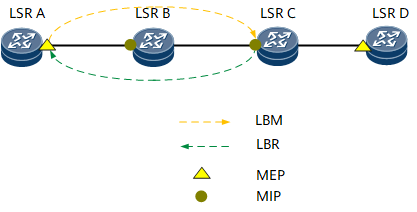Loopback
Background
On a multiprotocol label switching transport profile (MPLS-TP) network, a virtual circuit may traverse multiple exchanging devices (nodes), including maintenance association end points (MEPs) and maintenance association intermediate points (MIPs). Any faulty node or link fault in a virtual circuit may lead to the unavailability of the entire virtual circuit. Moreover, the fault cannot be located. Loopback (LB) can be configured on a source device (MEP) to detect or locate faults in links between the MEP and a MIP or between MEPs.
Related Concepts
Function |
Description |
Usage Scenario |
|---|---|---|
CC |
CC is a proactive OAM operation. It detects LOC faults between any two MEPs in a MEG. |
To only monitor the connectivity of a link between two MEPs or associate APS, choose CC. |
LB |
LB is an on-demand OAM operation. It monitors the connectivity of bidirectional links between a MEP and a MIP and between MEPs. |
To monitor the bidirectional connectivity of a link between a MEP and a MIP or a link between two MEPs and not to associate APS, choose LB. |
Implementation
The loopback function monitors the connectivity of bidirectional links between a MEP and a MIP and between MEPs.
- The source MEP sends a loopback message (LBM) to a destination. If a MIP is used as the destination, the TTL in the LBM must be equal to the number of hops from the source to the destination. LBM checks whether the target MIP ID carried by itself and the MIP ID are the same. If a MEP is used as the destination, the TTL must be greater than or equal to the number of hops to the destination. The TTL setting prevents the LBM from being discarded before reaching the destination.
- After the destination receives the LBM, it checks whether the target MIP ID or MEP ID matches the local MIP ID or MEP ID. If they do not match, the destination discards the LBM. If they match, the destination responds with a loopback reply (LBR).
- If the source MEP receives the LBR within a specified period of time, it considers the destination reachable and the loopback test successful. If the source MEP does not receive the LBR after the specified period of time elapses, it records a loopback test timeout and log information that is used to analyze the connectivity failure.
Figure 1 illustrates a loopback test. LSRA initiates a loopback test to LSRC on an LSP. The loopback test process is as follows:
- LSRA sends LSRC an LBM carrying a specified TTL and a MIP ID. LSRB transparently transmits the LBM to LSRC.
- Upon receipt, LSRC determines that the TTL carried in the LBM times out and checks whether the target MIP ID carried in the LBM matches the local MIP ID. If they do not match, LSRC discards the LBM. If they match, LSRC responds with an LBR.
- If LSRA receives the LBR within a specified period of time, it considers LSRC reachable. If LSRA fails to receive the LBR after a specified period of time elapses, LSRA considers LSRC unreachable and records log information that is used to analyze the connectivity failure.
